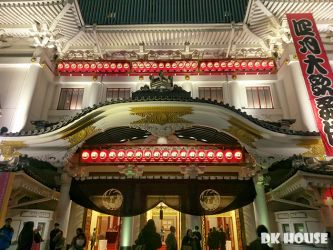DKハウス東京新小岩に住んでいるDylanさんが、歌舞伎を観劇しました。
彼はとても感激してくれたようで、以下の報告文を英語で届けてくれました!!
入居者の貴重な「生」の声、ということで、原文で載せてみます。↓↓
————————————————————————————————————————-
My apologies for how late this is. I hope it isn’t too late to add to the blog.
On April 3rd I had the pleasure of experiencing one of the oldest and most traditional forms of theater in the world called Kabuki. Kabuki theater is famous for its stylized dramatic performances centered around symbolic dances and movements, as well as the elaborate makeup worn by some performers.
The performance I attended was “The maiden at Dojoji Temple” and centered around a jealous woman who turns into a snake and kills the man who rejected her. As is traditional in Kabuki, the woman in the story is played by a man in elaborate makeup to make him look like a woman. The effect of this is very interesting, as the actor looks and moves in a way that is very feminine, to the extent of being a caricature of women instead of a faithful representation. Everything from the makeup, to the set pieces, to the costumes were vibrant with beautiful green, gold, and red colors and helped create a world of fantasy and spector that draws the audience in.
The show itself takes place over more than 3 hours, however I opted for a ticket to see only the last hour of the performance. The ticket was 1000 yen for seats furthest away from the stage. Despite this, I felt completely immersed in the world created by the set and mesmerized by the movements, dances, and songs performed by the actors.
I would not hesitate at all to recommend attending a Kabuki performance, especially one at the Kabuki-za theater in Ginza, Tokyo. It’s one of the easiest and most entertaining ways to be transported hundreds of years into Japan’s past and experience one of the oldest forms of entertainment in Japanese Culture.
————————————————————————————————————————
DKハウス新小岩
http://www.e-guesthouse.com/tokyo/
http://www.e-guesthouse.com/eng/

